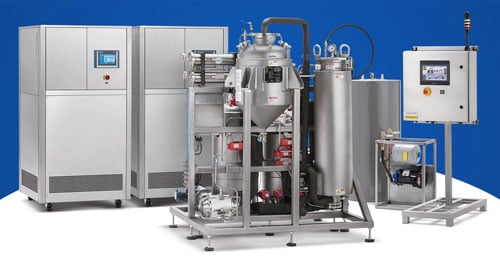As the cannabis concentrate market balloons to an estimated $8 billion in sales by 2022, business-savvy and licensed marijuana producers are making the measured investment in a professional closed-loop extraction system. Cannabis extraction equipment can increase profits and reduce processing costs associated with trimming and curing flower for many wholesalers. Concentrates command a higher price per item compared to flower (buds) and include a range of products such as odorless distillate oil for edibles or flavorful terp sauce for those with a more discerning palate.
Extract manufacturers are increasingly utilizing hydrocarbon extraction to strip cannabinoids, terpenes, flavonoids, and other active cannabis compounds from the hemp or cannabis plants. Compared to other popular extraction solvents such as ethanol and carbon dioxide (CO2), hydrocarbons (propane and butane) offer increased product quality and diversity, as well as an ability to scale operations to compete in the intense concentrate market.
.jpg?width=1200&name=Untitled%20design%20(61).jpg)
What Are Hydrocarbons?
Hydrocarbons are naturally-occurring compounds made up of hydrogen and carbon atoms. Hydrocarbons are formed from decomposed organic material and reside in the earth and rocks such as shale and limestone. These hydrocarbon oils are primarily used for various industrial purposes including fossil fuels for combustion. Apart from powering much of the world, hydrocarbons are extremely efficient at producing high-quality cannabis extracts.
Butane and Propane
Butane and propane are the most commonly used hydrocarbons for closed-loop BHO extraction. Both are considered “light hydrocarbons” due to their low molecular weight. Extract manufacturers can employ a single solvent or a blend of propane and butane to produce unique consistencies and improve the quality of the finished product. Propane and butane blends are often used to extract a greater amount of terpenes and produce a lighter-hued extract.
Butane is a non-polar solvent with a boiling point of 31.1ºF. Butane has a relatively low boiling point, which enables manufacturers to use lower temperatures without degrading volatile terpene compounds. Propane has an even lower boiling point of -43.6ºF compared to butane. The two solvents can extract varying ratios of cannabinoids and waxes, as well as preserve a strain’s original terpene profile. An increasing number of extraction solutions are able to handle a single or mixture of solvents.
Light Hydrocarbon Extraction Process
Light hydrocarbon-based extraction equipment produces a variety of high-quality products ranging from shatter, to wax, crumble, budder, diamonds, live resin, and high-terpene full-spectrum extracts (HTFSE). The entire manufacturing process occurs in extraction facilities that meet the appropriate building code, equipment specification, and safety regulations. Adhering to these ever-improving guidelines ensures production occurs in a safe and streamlined manner.
Closed-loop BHO extraction begins with a range of raw cannabis starting material including trim, freshly cured flowers, or flash-frozen buds. Hydrocarbon extraction allows an extractor to create different products to meet the voracious demand for concentrate-based products such as dabbables, vape pens, topicals, tinctures, etc. Cannabis material usually has been preserved in a vacuum or nitrogen-sealed bag to reduce compound degradation due to light, heat, and oxygen exposure.
During the extraction run, cold hyrdocarbon solvent is flushed over the cannabis matter into the material column. As the butane, propane, or blended mixture washes over the organic plant matter, the solvent is capable of dissolving cannabinoids, terpenes, flavonoids, phenolic amides, and sterols to craft a full-spectrum extract. After the dissolving process, the solvent is separated from the solution and the oil is collected for further processing.
Refinement techniques such as in-line de-waxing and winterization can filter waxes and lipids from the solution. In-line de-waxing in closed-loop extractors occurs when the waxes and lipids are removed during the extraction process through cold filtering. Winterization requires a second solvent (typically chilled ethanol) to help separate waxes and lipids in a separate process after extraction.
The refined concentrate is stored in the collection vessel, while the solvent is passively removed by heating the vessel. The boiled-off butane is captured in the solvent storage tank for re-use. Closed-loop systems ensure the majority of the butane is reclaimed for later use. Once the concentrate is ready, an extraction technician can collect the product and place it onto a parchment sheet or into a container.
Additional purging techniques may be employed depending on the desired product type. Extract consistencies require a specific process and purging practice to achieve the shelf-ready consistency. For example, wax requires it to undergo a whipping process to remove all of the residual solvent. For shatter products, the concentrated resin is spread evenly across a surface and left in an oven to purge for 12 to 48hours.
Investing in Scalable Equipment
Before investing in an extraction system, cannabis producers must perform their due diligence in assessing their estimated throughput, staff experience, temperatures needed, and location of the facility. When competing against corporate cannabis producers, manufacturers must employ lean manufacturing practices to reduce bottlenecks in production and packaging.
Newer hydrocarbon extraction equipment including Luna Technologies’ IO Extractor offers a blazing-fast and user-friendly system that can produce a full line of extracts at a high throughput rate. The IO Extractor’s pre-programmed recipes keep track of pressures, temperatures, and liquid levels removing the possibility of human error.
In a world where concentrate connoisseurs are developing expensive tastes for HTFSE, but novice users opt for shatters and waxes, a fully-automated light hydrocarbon extraction system gives extraction technicians the ability to produce multiple concentrate types for various cannabis consumer demographics.
Finally, light hydrocarbon extraction provides companies with an increase in throughput compared to other solvents such as CO2. In fact, CO2’s throughput is half that of BHO. While equipment costs can give investors pause, the system can pay for the increased upfront cost in a considerable way, especially with ready financing. Hydrocarbon extraction sees no signs of slowing down in this rapidly evolving concentrate market.



